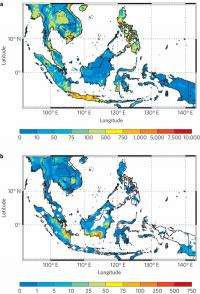August 13, 2012 report
Increased deaths from lung disease tied to more fires in Southeast Asia during El Nino

(Phys.org) -- Sometimes in science, it’s a matter of thinking about things in new ways. That’s what a team of US and British researchers have found after studying the numbers of fires that are set intentionally in Southeast Asia to clear forests during El Niño events as compared to so-called normal years, and the incidence of lung disease leading to deaths in the region. After studying a decade’s worth of satellite images, the team, as they describe in their paper published in Nature Climate Change, found what appears to be a correlation between El Niño events and increased deaths due to the pollutants in smoke from fires.
In the western world, people are used to associating an El Niño event with warmer waters in the Pacific Ocean, leading to altered weather patterns across North America. But the same events lead to cooler waters in the eastern Pacific, most specifically around Indonesia and Southeast Asia. That leads to less rainfall during the annual monsoon season, which allows for more burning of forests to produce more crop land. And burning more forests produces more smoke with the associated pollutants, which the team has found, might conceivably be adding up to 15,000 deaths per event.
To find these correlations, the team studied satellite images taken during the decade 1997 to 2006 to discern how many fires were being set and how much pollution they were generating. They then plugged that information into chemistry models to see how much of which pollutants would be generated by such fires. Because a strong El Niño occurred in 1997, the team was able to follow the chain reaction of events. They found that shortly after the event began, the number of fires picked up and fine particulates in the atmosphere increased to over 300 times the amount the World Health Organization has established as a safe benchmark, for a period of 200 days. They found that levels of ozone were also elevated. They compared this with data from the opposite type of event, a La Niña that occurred in 2000, bringing more than normal rain to the area and a reduction in the number of fires. Particulates from the fires that year were 98% lower than in 1997.
In studying the satellite images the team was also able to follow the track the pollutants took and found they were concentrated mostly around Indonesia and Malaysia. They then estimated the number of people that would die from the inhalation of the particulates based on the population of the area where the pollutants traveled and found they likely amount to between six and fourteen thousand deaths per event. Ozone from the fires likely add another two to six thousand deaths.
The one upside to the study, the authors suggest is that because the fires are man-made, they could be stopped given the right set of circumstances.
More information: El Niño and health risks from landscape fire emissions in southeast Asia, Nature Climate Change (2012) doi:10.1038/nclimate1658
Abstract
Emissions from landscape fires affect both climate and air quality. Here, we combine satellite-derived fire estimates and atmospheric modelling to quantify health effects from fire emissions in southeast Asia from 1997 to 2006. This region has large interannual variability in fire activity owing to coupling between El Niño-induced droughts and anthropogenic land-use change. We show that during strong El Niño years, fires contribute up to 200 μg m−3 and 50 ppb in annual average fine particulate matter (PM2.5) and ozone surface concentrations near fire sources, respectively. This corresponds to a fire contribution of 200 additional days per year that exceed the World Health Organization 50 μg m−3 24-hr PM2.5 interim target4 and an estimated 10,800 (6,800–14,300)-person (~ 2%) annual increase in regional adult cardiovascular mortality. Our results indicate that reducing regional deforestation and degradation fires would improve public health along with widely established benefits from reducing carbon emissions, preserving biodiversity and maintaining ecosystem services.
Journal information: Nature Climate Change
© 2012 Phys.org



















